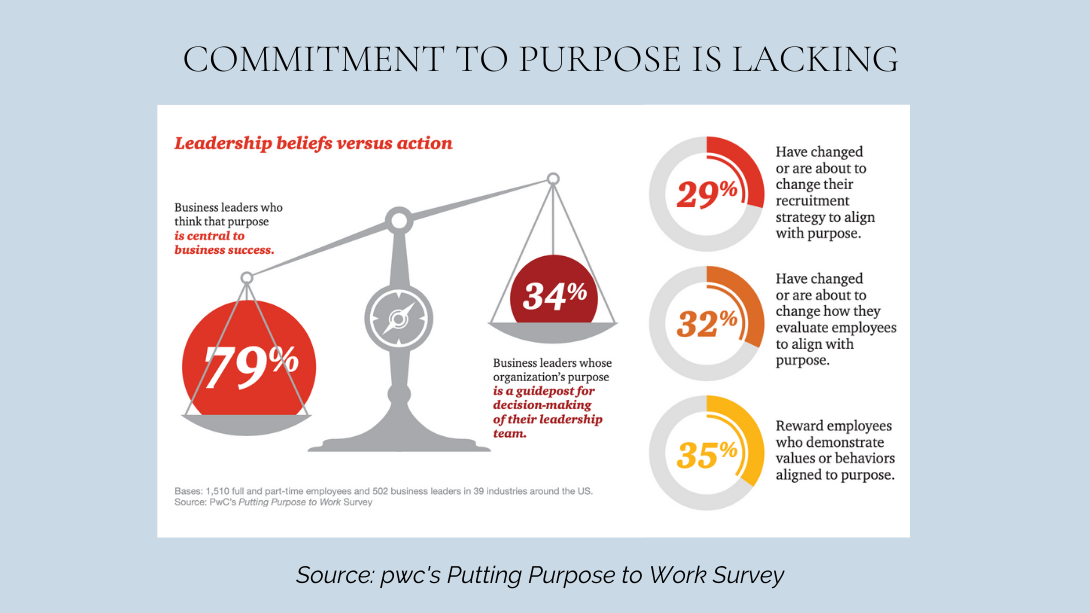The 3 Problems With Purpose - And How To Overcome Them

Writing a purpose. Have you tried it yet?
Defining a purpose really means identifying WHY a business exists. It’s one of the four questions you have to answer for a client when defining their brand strategy.
But do a quick Google of the topic, and you’ll see lots of scathing comments about purpose done badly or ‘purpose-washing’.
So how can you ensure you create the right answer for your client?
Well, start by understanding the 3 ways it goes wrong.
Problem with purpose 1: AUTHENTICITY
The first problem with purpose is lack of AUTHENTICITY. Or just not telling the truth.
There are some great purpose statements out there from brands like Tesla, Warby Parker and Patagonia.

But these don’t suit every brand.
If you’re not in business to save the planet, solve racial inequality, save the whales… then don’t pretend you are.
The idea that your brand needs to be ALL about social mission – that 'brand purpose' trumps everything else you do - is tripping up countless CEOs and founders.
Look instead at the sensible guidance from the Business Roundtable in 2019. They released a Statement on the Purpose of a Corporation that was signed by 181 CEOs who committed ‘to lead their companies for the benefit of all stakeholders – customers, employees, suppliers, communities and shareholders’.
Note the order here. Customers and employees first – not the whales.
Because if you’re a for-profit business, first and foremost you have to identify how you’re helping your customers and employees to thrive. Without understanding this, you won’t have a business much longer. It’s the first step in articulating how can have a positive impact on people AND make a profit. The next step is to also define how your business can benefit other communities – how you can do good as you grow.
This to me is the holy grail of PURPOSE statements, and is one of things I teach people to create for their clients in Brand Strategy Academy.
One authentic, relevant, phrase that addresses all the people who will ensure your business thrives. A statement that identifies how customers are helped, employees grow, and society benefits. One statement to inform marketing, HR, innovation, and ESG.
Consider Microsoft’s purpose: “to empower every person and every organization on the planet to achieve more."
Their technology clearly underpins this. Because that’s what they sell and how they will ensure they remain profitable.
But the statement also creates a platform for the Chairman and CEO, Satya Nadella, to focus on empowering a growth mindset in employees.
“He’s remained consistent to his belief that this growth mindset is critical for Microsoft and that it is very powerful… We have growth mindset memes on the coffee mugs and each week Satya has a “Mindset Moment” that he broadcasts to the entire organization. Sometimes it’s about something going on with a major initiative, sometimes just an observation or anecdote he wants to share. All of these efforts act as a subtle reinforcement.”
Cherise Mendoza, Head of HR, Microsoft Canada.
And the same purpose statement directs their ESG, with their global skills initiative having reached 30 million learners as of March 2021 and $1.9 billion contributed to non-profits in donated or discounted technology and services.
One statement – addressing all key stakeholders in an authentic way that’s rooted in what they create and sell.
Which leads us on to the second problem with purpose.
Problem with purpose 2: COHERENCE
Purpose statements are too often created in isolation from similar initiatives describing WHY a business exists, and, even more importantly, HOW people are expected to act in order to achieve it.
The CEO authors a purpose statement in 2020, Marketing created a brand promise in 2018, HR ‘did the values’ in 2015 and what are you left with? Writing on PowerPoint slide – not a connected and coherent strategy.
You see some of the world’s most famous brands struggling with this (see my piece on CISCO here). Even Nike have squished together their mission and purpose.

This conveniently forgets two of the most important guiding principles for creating any strategy: sacrifice and coherence.
“A good strategy doesn’t just draw on existing strength; it creates strength through the coherence of its design. Most organisations of any size don’t do this. Rather, they pursue multiple objectives that are unconnected with one another or, worse, that conflict with one another.”
Good Strategy, Bad Strategy – The difference and why it matters, Richard Rummelt
Ultimately this strength of this coherence is not just about clarity or unity - it leads to results, as Pfizer's CEO, Albert Bourla explains:
“If you stay true to your purpose and it is very clear to every person that is working in this company, then there is a very clear direction, there is a compass, there is a star that is telling you this is where we all go. That unites the organization, creates cohesiveness, and brings results.”
So don’t just layer a purpose on top of the rest of the mess in your ‘brand onion', or 'brand key' or whatever overly-complicated model you've been saddled you with. Do the work to define WHY you exist, and WHO you need to be and HOW you need to do things in order to live up to this WHY. Then write this up as one cohesive strategy and retire the rest.
Articulating a purpose is making a choice about WHY your business exists, but as Willie Petersen writes in Strategy Is an Art of Sacrifice,
“A choice is not a choice until we decide what we will give up. We must subtract first, then multiply."
Problem with purpose 3: COMMITMENT
It’s not enough to hand off a purpose statement to your ad agency to create a lovely launch video and campaign. It must guide how you act as an organisation.
"What separates a truly great brand from one that is merely good is whether the company is capable of a complete and thorough implementation of its brand as its business."
Denise Lee Yohn, What Great Brands Do
In pwc’s ‘Putting Purpose To Work’ survey, although 79% of business leaders agreed that purpose is central to business success, only 34% were actually using it as a guidepost for decision making, and only a third were aligning recruitment strategy, employee evaluations and rewards with why they said they were in business.

When this happens it’s only a matter of time before we loop back to number 1 on our list. Suddenly the purpose you’re putting out into the world is not seen to be authentic. Employees aren’t being tasked to deliver it, nobody's measured on it, leadership aren’t talking about it and customers begin to call you out as ‘purpose-washing’.
A new brand strategy is a signpost at the start of a journey, not a completed project. It doesn’t just require coherence in its articulation, it requires coherent action.
As Richard Rummelt explains in Good Strategy, Bad Strategy, "Many people assume that a strategy is a big-picture overall direction, divorced from any specific action. But defining strategy as broad concepts, thereby leaving out action, creates a wide chasm between “strategy” and “implementation.”
“[It’s] a journey that requires constant and relentless commitment. Not surprisingly that requires Satya, and our other leaders, to keep reinforcing it again and again in their actions and in their communications. That relentless commitment is critical. And, over time, we’ve started to see this starting to breathe and take off inside the organization.”
Cherise Mendoza, Head of HR, Microsoft Canada.
Authenticity, coherence and commitment. The commitment feeds the authenticity, but only if people inside first have clarity on what they are committing to.
So in summary:
Define your purpose carefully – with the right research inputs and leadership engagement, and as part of a cohesive brand strategy. Ensure it’s an authentic, relevant phrase that addresses all the people who will ensure your business thrives. Then commit for the long term.
If you want to know how to develop an authentic, cohesive brand strategy, that clients are engaged with and committed to, join me in Brand Strategy Academy.

Get brand strategy smarter in 5 minutes a week
Join our weekly newsletter. No fluff. Sent Fridays.
By clicking the button, you agree to receive the 'Brand Strategy Smarter' newsletter and marketing emails from Brand Strategy Sarah about our products and services. Unsubscribe at any time.


